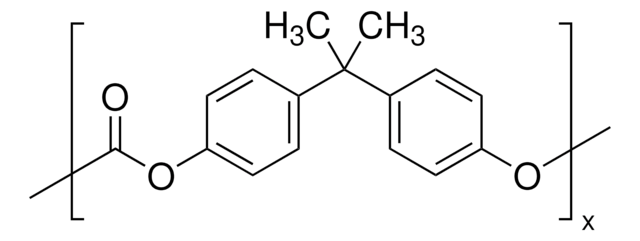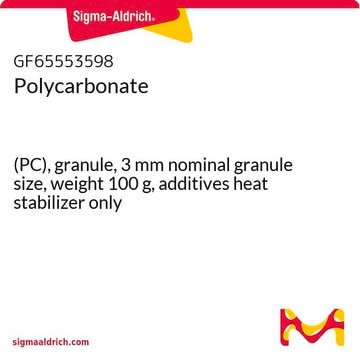181625
Poly(Bisphenol A carbonate)
average Mw ~45,000 by GPC
Sinónimos:
4,4′-Dihydroxydiphenyl-2,2-propane carbonate polymer, Bisphenol A carbonate homopolymer, Carbonic acid-4,4′-dihydroxydiphenyl-2,2-propane copolymer, Poly(dian carbonate), Poly[2,2-bis(4-hydroxyphenyl)propane carbonate]
About This Item
Productos recomendados
mol peso
average Mw ~45,000 by GPC
índice de refracción
n20/D 1.585
temperatura de transición
Tg 150 °C
Tm 267 °C
densidad
1.2 g/mL at 25 °C (lit.)
cadena SMILES
CC(C)(c1ccc(O)cc1)c2ccc(O)cc2
InChI
1S/C15H16O2.CH2O3/c1-15(2,11-3-7-13(16)8-4-11)12-5-9-14(17)10-6-12;2-1(3)4/h3-10,16-17H,1-2H3;(H2,2,3,4)
Clave InChI
XSXWYGABGYBZRM-UHFFFAOYSA-N
Información sobre el gen
mouse ... Esr1(13982)
rat ... Ar(24208)
¿Está buscando productos similares? Visita Guía de comparación de productos
Descripción general
Aplicación
- To prepare transparent nanocomposites for optical applications.
- To study the wettability of graphene.
Código de clase de almacenamiento
11 - Combustible Solids
Clase de riesgo para el agua (WGK)
WGK 3
Punto de inflamabilidad (°F)
Not applicable
Punto de inflamabilidad (°C)
Not applicable
Equipo de protección personal
Eyeshields, Gloves, type N95 (US)
Certificados de análisis (COA)
Busque Certificados de análisis (COA) introduciendo el número de lote del producto. Los números de lote se encuentran en la etiqueta del producto después de las palabras «Lot» o «Batch»
¿Ya tiene este producto?
Encuentre la documentación para los productos que ha comprado recientemente en la Biblioteca de documentos.
Los clientes también vieron
Nuestro equipo de científicos tiene experiencia en todas las áreas de investigación: Ciencias de la vida, Ciencia de los materiales, Síntesis química, Cromatografía, Analítica y muchas otras.
Póngase en contacto con el Servicio técnico










